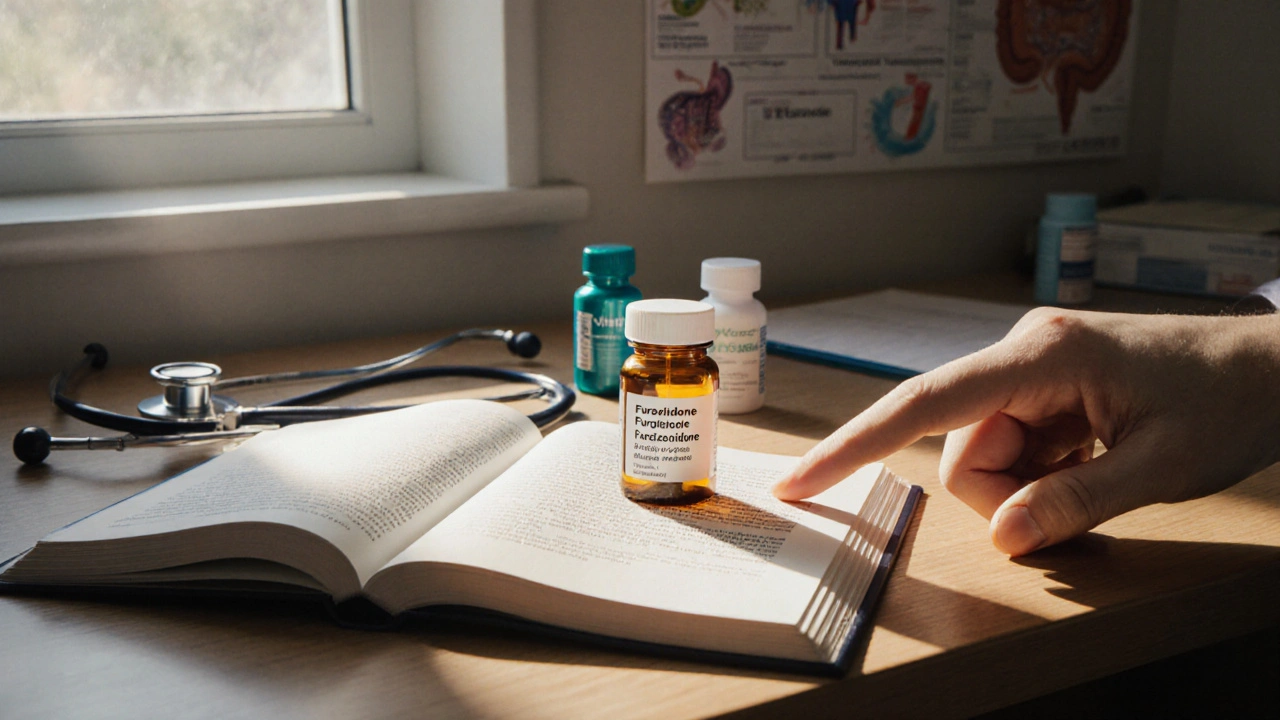Furazolidone Alternative Recommender
Find the best alternative to furazolidone
Select the infection type and patient factors to see which antibiotic alternative is most appropriate.
Quick Takeaways
- Furazolidone is a nitrofuran antibiotic with strong activity against certain diarrheal bugs, but its use is limited by safety concerns and regulatory bans in many countries.
- Metronidazole and tinidazole are the go‑to nitroimidazoles for most anaerobic infections; they are cheaper, better tolerated, and widely available.
- Ciprofloxacin and doxycycline provide broader gram‑negative coverage and are useful when resistantorganisms are suspected.
- Azithromycin offers a convenient once‑daily regimen and is safe for most patients, though resistance is rising.
- Choosing an alternative depends on infection type, local resistance patterns, patient comorbidities, and drug‑interaction risk.
When a doctor prescribes furazolidone, many patients wonder whether there’s a safer, easier‑to‑find option. The drug belongs to the nitrofuran class and used to be a staple for travel‑related diarrhea, cholera, and some protozoal infections. However, regulatory agencies in the U.S., EU, and several Asian nations have either restricted or withdrawn it because of carcinogenicity worries and liver toxicity reports. This article breaks down the most common alternatives, compares key attributes side‑by‑side, and helps you decide when furazolidone might still be the right choice.
What Is Furazolidone?
Furazolidone is a synthetic nitrofuran antimicrobial that interferes with bacterial DNA synthesis and disrupts protein synthesis. It was first introduced in the 1950s and gained popularity for treating gastrointestinal infections caused by Shigella, Campylobacter, and certain protozoa such as Giardia lamblia. The typical adult dose is 100mg three times daily for 5‑7days.
Regulatory status varies widely: the FDA lists it as an “unapproved new drug,” the European Medicines Agency withdrew it in 1999, while countries like India and Brazil still allow limited use under strict prescription. Common side effects include nausea, headache, and a metallic taste. More serious concerns involve hepatic enzyme elevation, hemolytic anemia in G6PD‑deficient patients, and rare reports of mutagenicity in animal studies.
Why Look for Alternatives?
Several practical reasons push clinicians and patients toward other agents:
- Safety profile: Hepatotoxicity and hemolysis are not trivial, especially in patients with pre‑existing liver disease.
- Regulatory restrictions: Many pharmacies in Western countries no longer stock furazolidone.
- Resistance trends: Overuse in some regions has led to decreasing susceptibility of Shigella spp.
- Convenience: Alternative drugs often require fewer daily doses, improving adherence.
When any of these factors apply, swapping to an evidence‑based alternative can maintain efficacy while reducing risk.

Top Alternatives Overview
Below are the six most frequently recommended substitutes, each with a brief snapshot.
- Metronidazole - a nitroimidazole that targets anaerobic bacteria and protozoa. Dosage: 250mgq8h for 5‑7days.
- Tinidazole - similar spectrum to metronidazole but with a longer half‑life, allowing single‑dose regimens. Dosage: 2gsingle dose for most infections.
- Ciprofloxacin - a fluoroquinolone with strong gram‑negative coverage, useful for travel‑related diarrhea caused by Campylobacter. Dosage: 500mgbid for 3‑5days.
- Doxycycline - a tetracycline that covers a broad range of bacterial pathogens, including atypical and intracellular organisms. Dosage: 100mgbid for 7days.
- Azithromycin - a macrolide with convenient once‑daily dosing, effective against many diarrheal pathogens. Dosage: 500mgday1 then 250mgdaily for 4more days.
- Nitrofurantoin - primarily used for urinary‑tract infections but occasionally employed for gastrointestinal bugs in low‑dose regimens. Dosage: 100mgtid for 5‑7days.
Side‑by‑Side Comparison
| Drug | Class | Typical Indications | Standard Adult Dose | Common Side Effects | Major Safety Concerns | Regulatory Status (2025) |
|---|---|---|---|---|---|---|
| Furazolidone | Nitrofuran | Travel‑associated diarrhea, giardiasis | 100mg TID 5‑7days | Nausea, headache, metallic taste | Hepatotoxicity, hemolysis in G6PD‑deficiency, mutagenicity alerts | Restricted/withdrawn in US, EU; allowed with prescription in India, Brazil |
| Metronidazole | Nitroimidazole | Anaerobic infections, giardiasis, bacterial vaginosis | 250mg q8h 5‑7days | Metallic taste, nausea, diarrhoea | Alcohol‑disulfiram reaction, peripheral neuropathy with prolonged use | Approved worldwide |
| Tinidazole | Nitroimidazole | Giardiasis, trichomoniasis, anaerobic infections | 2g single dose | Headache, metallic taste, mild GI upset | Similar to metronidazole; less data on long‑term neuropathy | Approved in EU, Asia; limited US use |
| Ciprofloxacin | Fluoroquinolone | Travel‑associated diarrhea, urinary‑tract infections | 500mg bid 3‑5days | GI upset, tendon pain, QT prolongation | Tendon rupture risk, CNS effects, resistance development | Approved globally, but with boxed warning in US/EU |
| Doxycycline | Tetracycline | Travel‑related diarrhoea, rickettsial diseases, acne | 100mg bid 7days | Photosensitivity, esophagitis, GI upset | Contraindicated in pregnancy, children <8yrs | Widely approved |
| Azithromycin | Macrolide | Campylobacter, shigellosis, atypical pneumonia | 500mg day1 then 250mg daily ×4days | Diarrhoea, nausea, mild QT prolongation | Resistance rising in Shigella, drug‑interaction with statins | Approved worldwide |
| Nitrofurantoin | Nitrofuran (UTI‑specific) | Uncomplicated urinary‑tract infection | 100mg tid 5‑7days | GI upset, metallic taste, rare pulmonary toxicity | Not ideal for GFR <30ml/min, rare hepatotoxicity | Approved in US, EU; off‑label GI use limited |
When to Prefer Furazolidone vs. Alternatives
Deciding whether to stick with furazolidone hinges on three practical questions:
- Is the infection caused by a pathogen known to be resistant to the first‑line agents? In parts of South Asia, Shigella dysenteriae shows >30% resistance to azithromycin and metronidazole. Here, furazolidone’s unique mechanism can be a rescue drug.
- Does the patient have liver disease, G6PD deficiency, or is pregnant? If yes, steer clear of furazolidone and opt for metronidazole or azithromycin, which have cleaner safety records.
- Is the drug readily available locally? In many Western pharmacies, furazolidone isn’t stocked. If you can’t source it reliably, choose an alternative that you can obtain without delay.
In short, reserve furazolidone for resistant, travel‑related cases where alternatives fail, and the patient has no contraindications.

Safety & Drug‑Interaction Highlights
Understanding the interaction landscape prevents nasty surprises:
- Alcohol: Combining furazolidone with alcohol can trigger a disulfiram‑like reaction (flushing, palpitations). The same warning applies to metronidazole and tinidazole.
- Anticoagulants: Ciprofloxacin and azithromycin can enhance warfarin’s effect; monitor INR closely.
- Statins: Azithromycin may increase serum levels of certain statins, raising the risk of myopathy.
- Proton‑pump inhibitors: Doxycycline’s absorption drops when taken with PPIs; separate dosing by at least 2hours.
Always review a patient’s medication list before picking an antibiotic, especially if they’re on chronic therapies.
Practical Tips for Patients
- Take the medicine with food if it irritates your stomach, but avoid dairy with doxycycline and azithromycin as calcium can impede absorption.
- Complete the full course-even if you feel better after 2days. Stopping early fuels resistance.
- Stay hydrated, especially with nitrofurantoin or ciprofloxacin, to reduce kidney‑related side effects.
- Report any yellowing of the skin, dark urine, or sudden joint pain to a clinician immediately; these could signal liver or tendon issues.
- Carry a short list of your current meds when you visit the pharmacy; it helps the pharmacist spot interactions.
Frequently Asked Questions
Is furazolidone still legal to prescribe in the United States?
No. The FDA has not approved furazolidone for any indication, and it is classified as an unapproved new drug. Physicians can only obtain it through compassionate‑use programs or clinical trials.
When should I choose metronidazole over furazolidone?
Metronidazole is the first‑line choice for most anaerobic and protozoal infections because it is safer, cheaper, and widely available. Reserve furazolidone for cases where the pathogen is proven resistant to metronidazole or when the patient cannot tolerate nitroimidazoles.
Can I take furazolidone if I have a G6PD deficiency?
No. Furazolidone can trigger hemolytic anemia in people with G6PD deficiency. Alternatives such as azithromycin or doxycycline are safer options.
What is the quickest single‑dose alternative to furazolidone for giardiasis?
Tinidazole 2g as a single dose has shown cure rates above 90% for giardiasis and is much more convenient than a multi‑day furazolidone regimen.
Are there any food restrictions while taking doxycycline?
Avoid taking doxycycline with dairy products, calcium supplements, or antacids within two hours of the dose, as calcium binds the drug and reduces absorption.
By weighing the infection’s cause, the patient’s health status, and the local drug‑availability landscape, you can pick an antibiotic that hits the bug without bringing unnecessary side effects. Whether you stay with furazolidone or switch to metronidazole, azithromycin, or another agent, the goal is the same: clear the infection fast and safely.

George Frengos
October 13, 2025 AT 15:20While furazolidone remains a viable option in certain contexts, the alternatives listed-metronidazole, tinidazole, ciprofloxacin, doxycycline, azithromycin, and nitrofurantoin-provide comparable efficacy with more favorable safety profiles.
Please consider patient‑specific factors such as pregnancy status, hepatic function, and local resistance patterns before selecting therapy.
Jonathan S
October 27, 2025 AT 06:00It is incumbent upon every responsible prescriber to eschew the allure of outdated, potentially hazardous agents like furazolidone when safer, evidence‑based alternatives exist 😇. The medical profession is built upon a foundation of rigor, accountability, and an unwavering commitment to do no harm 🙏. To cling to a drug that has been withdrawn in numerous jurisdictions betrays a neglect of regulatory wisdom and patient safety. Moreover, the specter of hepatotoxicity and hemolytic anemia in G6PD‑deficient individuals cannot be dismissed as a mere inconvenience. A prudent clinician must weigh the empirical data, prioritize drugs with well‑characterized safety margins, and educate patients about the rationale behind the chosen regimen. When the choice is between a molecule with a dubious mutagenic profile and a modern antibiotic with a transparent side‑effect spectrum, the ethical path is unmistakable. Let us therefore champion stewardship, embrace contemporary therapeutics, and safeguard the trust placed in us by the public 😊.
Charles Markley
November 9, 2025 AT 20:40From a pharmacodynamic perspective, furazolidone's nitrofuran scaffold epitomizes a suboptimal risk‑benefit ratio, especially when juxtaposed against the pharmacokinetic predictability of fluoroquinolones and macrolides. The molecular liability of oxidative stress induction, coupled with regulatory censure, renders its clinical utility obsolete. In contemporary antimicrobial stewardship algorithms, furazolidone is relegated to a peripheral niche, superseded by agents with superior MIC profiles and attenuated off‑target effects. Consequently, its prescription should be circumscribed to refractory cases where susceptibility data unequivocally demonstrate superiority over first‑line options.
Amy Morris
November 23, 2025 AT 11:20It is understandable to feel apprehensive when your physician recommends a medication that carries a litany of potential side effects. The anxiety surrounding liver toxicity or hemolysis can be overwhelming, particularly for those with pre‑existing conditions. Rest assured that the alternatives highlighted in the article have been meticulously vetted for safety and tolerability. By selecting a regimen tailored to your unique health profile, you can mitigate risks while still achieving therapeutic success. Your wellbeing remains the paramount priority, and open dialogue with your healthcare provider is essential to navigate these decisions.
Francesca Roberts
December 7, 2025 AT 02:00Oh great, another “miracle drug” that’s apparently “still around” because someone forgot to read the label about liver damage. Sure, let’s just ignore the fact that it’s banned in half the world and hope for the best. If you enjoy living on the edge of a possible mutagenic nightmare, furazolidone is your ticket. Otherwise, there are plenty of safer choices that actually have a legit approval.